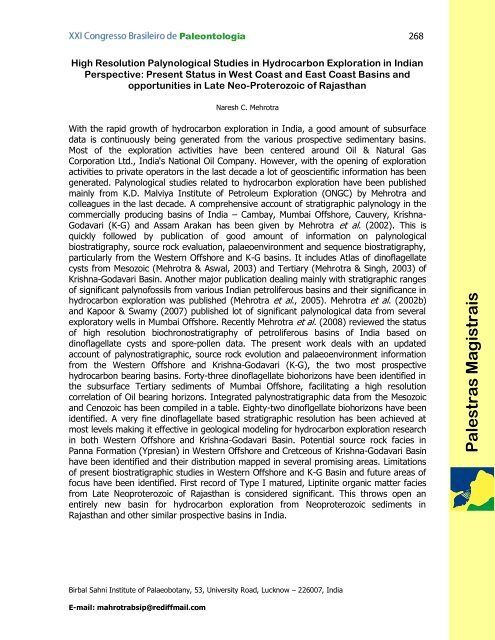Livro de Resumos - Dinossauros do Maranhão
Livro de Resumos - Dinossauros do Maranhão
Livro de Resumos - Dinossauros do Maranhão
Create successful ePaper yourself
Turn your PDF publications into a flip-book with our unique Google optimized e-Paper software.
Paleontologia 268<br />
High Resolution Palynological Studies in Hydrocarbon Exploration in Indian<br />
Perspective: Present Status in West Coast and East Coast Basins and<br />
opportunities in Late Neo-Proterozoic of Rajasthan<br />
Birbal Sahni Institute of Palaeobotany, 53, University Road, Lucknow – 226007, India<br />
E-mail: mahrotrabsip@rediffmail.com<br />
Naresh C. Mehrotra<br />
With the rapid growth of hydrocarbon exploration in India, a good amount of subsurface<br />
data is continuously being generated from the various prospective sedimentary basins.<br />
Most of the exploration activities have been centered around Oil & Natural Gas<br />
Corporation Ltd., India's National Oil Company. However, with the opening of exploration<br />
activities to private operators in the last <strong>de</strong>ca<strong>de</strong> a lot of geoscientific information has been<br />
generated. Palynological studies related to hydrocarbon exploration have been published<br />
mainly from K.D. Malviya Institute of Petroleum Exploration (ONGC) by Mehrotra and<br />
colleagues in the last <strong>de</strong>ca<strong>de</strong>. A comprehensive account of stratigraphic palynology in the<br />
commercially producing basins of India – Cambay, Mumbai Offshore, Cauvery, Krishna-<br />
Godavari (K-G) and Assam Arakan has been given by Mehrotra et al. (2002). This is<br />
quickly followed by publication of good amount of information on palynological<br />
biostratigraphy, source rock evaluation, palaeoenvironment and sequence biostratigraphy,<br />
particularly from the Western Offshore and K-G basins. It inclu<strong>de</strong>s Atlas of dinoflagellate<br />
cysts from Mesozoic (Mehrotra & Aswal, 2003) and Tertiary (Mehrotra & Singh, 2003) of<br />
Krishna-Godavari Basin. Another major publication <strong>de</strong>aling mainly with stratigraphic ranges<br />
of significant palynofossils from various Indian petroliferous basins and their significance in<br />
hydrocarbon exploration was published (Mehrotra et al., 2005). Mehrotra et al. (2002b)<br />
and Kapoor & Swamy (2007) published lot of significant palynological data from several<br />
exploratory wells in Mumbai Offshore. Recently Mehrotra et al. (2008) reviewed the status<br />
of high resolution biochronostratigraphy of petroliferous basins of India based on<br />
dinoflagellate cysts and spore-pollen data. The present work <strong>de</strong>als with an updated<br />
account of palynostratigraphic, source rock evolution and palaeoenvironment information<br />
from the Western Offshore and Krishna-Godavari (K-G), the two most prospective<br />
hydrocarbon bearing basins. Forty-three dinoflagellate biohorizons have been i<strong>de</strong>ntified in<br />
the subsurface Tertiary sediments of Mumbai Offshore, facilitating a high resolution<br />
correlation of Oil bearing horizons. Integrated palynostratigraphic data from the Mesozoic<br />
and Cenozoic has been compiled in a table. Eighty-two dinoflgellate biohorizons have been<br />
i<strong>de</strong>ntified. A very fine dinoflagellate based stratigraphic resolution has been achieved at<br />
most levels making it effective in geological mo<strong>de</strong>ling for hydrocarbon exploration research<br />
in both Western Offshore and Krishna-Godavari Basin. Potential source rock facies in<br />
Panna Formation (Ypresian) in Western Offshore and Cretceous of Krishna-Godavari Basin<br />
have been i<strong>de</strong>ntified and their distribution mapped in several promising areas. Limitations<br />
of present biostratigraphic studies in Western Offshore and K-G Basin and future areas of<br />
focus have been i<strong>de</strong>ntified. First record of Type I matured, Liptinite organic matter facies<br />
from Late Neoproterozoic of Rajasthan is consi<strong>de</strong>red significant. This throws open an<br />
entirely new basin for hydrocarbon exploration from Neoproterozoic sediments in<br />
Rajasthan and other similar prospective basins in India.<br />
Palestras Magistrais


